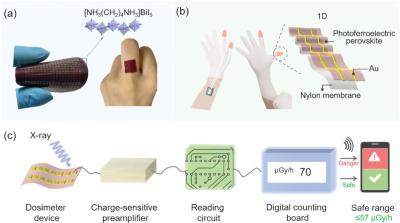Researchers from China's Shaanxi Normal University, Zhejiang Normal University, China Institute of Radiation Protection and Chinese Academy of Sciences have developed lead-free photoferroelectric hybrid metal halide perovskite flexible membranes for wearable detectors, that offer excellent X-ray response with high sensitivities, low detection limit and impressive imaging capabilities.
Demonstration and application potential for lead-free photoferroelectric perovskite membrane (LFPPM). a) Optical images of the LFPPM. b) Schematic diagram of LFPPM wearable X-ray dosimeter. c) Schematic diagram of the working principle of wearable X-ray dosimeter. (Image credit: Nanowerk)
High-sensitivity wearable radiation detectors are important for personnel protection in radiation environments such as defense, nuclear facilities, and medical fields. Traditional detectors using bulk crystals tend to lack flexibility. Hybrid metal halide perovskites have shown promise for next-generation radiation detection as they can efficiently absorb high-energy radiation and convert it into electrical signals. However, there are concerns of lead toxicity. More recent efforts have explored lead-free alternatives, but these have generally suffered from poor charge transport properties, reducing their effectiveness as radiation detectors.
According to the team, a key challenge has been balancing the competing needs for flexibility, non-toxicity, and high performance. Bulk crystals can achieve good sensitivity but lack the mechanical properties needed for wearable devices. Thin films offer improved flexibility but often at the cost of reduced radiation absorption and charge collection. Additionally, many promising perovskite materials degrade quickly when exposed to moisture or mechanical stress, limiting their real-world applicability.
Recent advances in materials science and nanofabrication have opened up new possibilities for addressing these obstacles. In particular, the discovery of photoferroelectric properties in certain perovskite structures has provided a potential pathway to efficient charge separation and transport without relying on toxic lead. Concurrently, new fabrication techniques have emerged for creating flexible membranes that maintain the desirable properties of bulk materials.
Now, the researchers have leveraged these developments to create a novel class of flexible, lead-free photoferroelectric perovskite membranes for X-ray detection. Their work demonstrates X-ray detectors with sensitivity rivaling or exceeding current commercial options while offering the mechanical properties needed for wearable devices.
The team focused on a lead-free perovskite material with the chemical formula [NH3(CH2)4NH3]BiI5. This compound is a hybrid metal halide perovskite, which combines organic and inorganic components in a crystalline structure. The researchers developed a method to embed this perovskite within a flexible nylon polymer membrane, creating large-area flexible sheets.
A key innovation in this work is the use of a photoferroelectric perovskite. Ferroelectric materials possess a spontaneous electric polarization that can be reversed by an applied electric field. In photoferroelectric materials, this property can help separate and transport charge carriers generated by incident radiation. The researchers hypothesized that this effect could compensate for the typically poor charge transport in lead-free perovskites.
To investigate the formation and properties of their flexible membranes, the team employed advanced characterization techniques. They used in situ X-ray scattering to observe the crystallization process in real-time, revealing a multi-stage transformation from precursor solution to the final perovskite structure. Atomic force microscopy and Kelvin probe force microscopy demonstrated the uniformity of the resulting membranes. Importantly, the researchers confirmed the ferroelectric nature of their material using piezoresponse force microscopy. They observed distinct ferroelectric domains that could be switched by an applied electric field - a key requirement for leveraging the photoferroelectric effect in radiation detection.
The X-ray detection performance of the flexible membranes reportedly proved exceptional. At an applied bias of 50 volts, the detectors achieved a sensitivity of 7872 µC Gyair−1 cm−2. This value surpasses previously reported flexible, lead-free perovskite detectors by a significant margin. Perhaps even more impressively, the detectors maintained high sensitivity (394 µC Gyair−1 cm−2) even without an applied bias, operating in a "self-driven" mode enabled by the built-in electric field of the ferroelectric material.
The detectors also demonstrated a very low limit of detection - less than 77 nGyair−1. This is approximately 70 times lower than the typical dose rate used in routine medical X-ray imaging, highlighting the potential for these devices to detect even very low levels of radiation.
Beyond raw performance metrics, the flexible membranes showed excellent stability under various challenging conditions. The materials maintained their structure and performance after three weeks of exposure to ambient air, demonstrating good long-term stability. They also retained about 90% of their initial sensitivity after 5000 seconds of repeated bending, indicating promising mechanical durability. Perhaps most surprisingly, the membranes showed strong water resistance, retaining 85% of their performance even after being submerged in water.
To assess the potential for real-world applications, the researchers evaluated their detectors' response to different types of radiation. The devices maintained good sensitivity even when exposed to higher-energy gamma rays (661 keV), although with some expected reduction compared to lower-energy X-rays. They also demonstrated consistent performance across a wide range of incident angles, meeting international standards for personal dosimeters.
The combination of high sensitivity, flexibility, and stability demonstrated in this work represents a step toward practical wearable radiation detectors. Such devices could find applications in various fields where personnel are at risk of radiation exposure, including healthcare, nuclear energy, and space exploration. Wearable dosimeters could provide real-time, personalized monitoring of radiation exposure, enhancing safety protocols in these high-risk environments.
However, it's important to note that several challenges remain before these materials can be integrated into commercial wearable devices. Further research is needed to optimize the manufacturing process for large-scale production, ensure long-term reliability under real-world conditions, and develop the necessary readout and data processing electronics for a complete wearable system.
This work also contributes to the broader understanding of how ferroelectric properties can enhance charge transport in perovskite materials. This insight could have implications beyond radiation detection, potentially informing the development of improved solar cells, light-emitting diodes, and other optoelectronic devices based on similar material systems.




